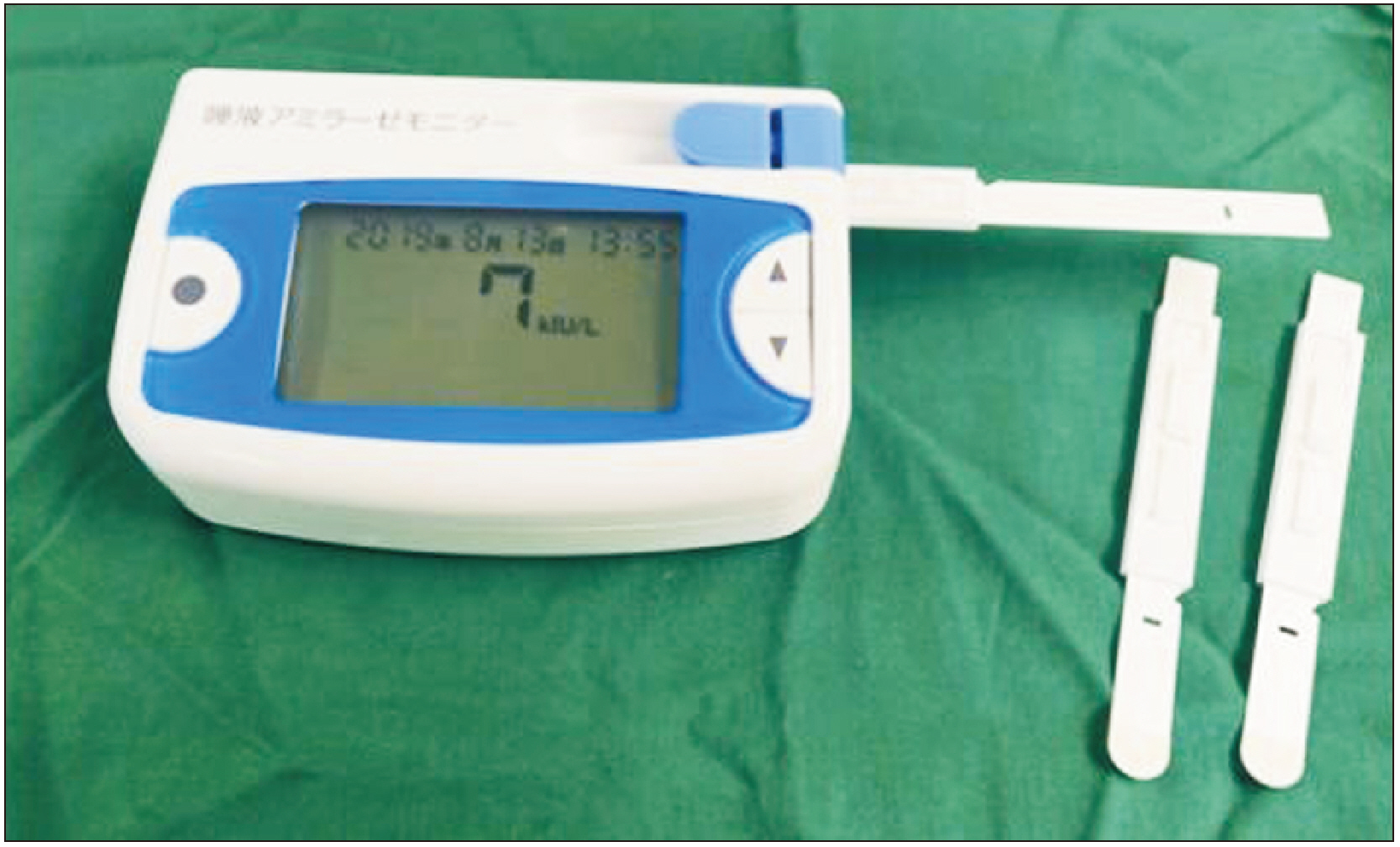J Korean Assoc Oral Maxillofac Surg.
2020 Aug;46(4):235-239. 10.5125/jkaoms.2020.46.4.235.
Comparative evaluation of salivary alpha amylase level for assessment of stress during third molar surgery with and without piano music and co-relation with pain catastrophizing scale: an in vivo study
- Affiliations
-
- 1Department of Oral & Maxillofacial Surgery, Dr. D. Y. Patil Vidyapeeth, Pune, India
- KMID: 2505438
- DOI: http://doi.org/10.5125/jkaoms.2020.46.4.235
Abstract
Objectives
Preoperative nervousness and anxiety are frequently encountered by individuals who undergo extractions of impacted wisdom teeth. The aim of the present study is to evaluate salivary alpha amylase (sAA) level in patients for assessment of stress during third molar surgery while listening to piano music and to determine its co-relation with pain catastrophizing scale (PCS).
Materials and Methods
Seven patients (four males and three females) indicated for surgical extraction of bilaterally impacted mandibular third molars were included. Pre-surgical patient assessments were completed, and three samples of saliva were collected during surgery—one at baseline, one 30 minutes after commencement of surgery, and one after suturing. Assessment was performed on both sides separately with and without piano music, and the samples were assessed for sAA level and correlated with the patient’s self-reported PCS.
Results
Statistically significant results were obtained in patients who underwent surgical extraction while listening to piano music (p=0.046). The correlation of sAA level with PCS was not significant.
Conclusion
Music demonstrated a beneficial effect on lowering the levels of stress and anxiety that a patient exhibits during any surgical procedure, and sAA can be a useful biomarker for similar assessments.
Figure
Reference
-
References
1. Robles TF, Sharma R, Park KS, Harrell L, Yamaguchi M, Shetty V. 2012; Utility of a salivary biosensor for objective assessment of surgery-related stress. J Oral Maxillofac Surg. 70:2256–63. https://doi.org/10.1016/j.joms.2012.03.005 . DOI: 10.1016/j.joms.2012.03.005. PMID: 22677332. PMCID: PMC5104531.
Article2. Kiecolt-Glaser JK, Page GG, Marucha PT, MacCallum RC, Glaser R. 1998; Psychological influences on surgical recovery. Perspectives from psychoneuroimmunology. Am Psychol. 53:1209–18. https://doi.org/10.1037/0003-066X.53.11.1209 . DOI: 10.1037/0003-066X.53.11.1209. PMID: 9830373.
Article3. Edwards RR, Fillingim RB, Maixner W, Sigurdsson A, Haythornthwaite J. 2004; Catastrophizing predicts changes in thermal pain responses after resolution of acute dental pain. J Pain. 5:164–70. https://doi.org/10.1016/j.jpain.2004.02.226 . DOI: 10.1016/j.jpain.2004.02.226. PMID: 15106129.
Article4. Sullivan MJ, Thorn B, Haythornthwaite JA, Keefe F, Martin M, Bradley LA, et al. 2001; Theoretical perspectives on the relation between catastrophizing and pain. Clin J Pain. 17:52–64. https://doi.org/10.1097/00002508-200103000-00008 . DOI: 10.1097/00002508-200103000-00008. PMID: 11289089.
Article5. Sullivan MJ, Neish NR. 1998; Catastrophizing, anxiety and pain during dental hygiene treatment. Community Dent Oral Epidemiol. 26:344–9. https://doi.org/10.1111/j.1600-0528.1998.tb01971.x . DOI: 10.1111/j.1600-0528.1998.tb01971.x. PMID: 9792127.
Article6. Nater UM, Rohleder N, Gaab J, Berger S, Jud A, Kirschbaum C, et al. 2005; Human salivary alpha-amylase reactivity in a psychosocial stress paradigm. Int J Psychophysiol. 55:333–42. https://doi.org/10.1016/j.ijpsycho.2004.09.009 . DOI: 10.1016/j.ijpsycho.2004.09.009. PMID: 15708646.
Article7. Nater UM, Rohleder N. 2009; Salivary alpha-amylase as a non-invasive biomarker for the sympathetic nervous system: current state of research. Psychoneuroendocrinology. 34:486–96. https://doi.org/10.1016/j.psyneuen.2009.01.014 . DOI: 10.1016/j.psyneuen.2009.01.014. PMID: 19249160.
Article8. Bosch JA, Veerman EC, de Geus EJ, Proctor GB. 2011; α-Amylase as a reliable and convenient measure of sympathetic activity: don't start salivating just yet! Psychoneuroendocrinology. 36:449–53. https://doi.org/10.1016/j.psyneuen.2010.12.019 . DOI: 10.1016/j.psyneuen.2010.12.019. PMID: 21295411.
Article9. Shetty V, Zigler C, Robles TF, Elashoff D, Yamaguchi M. 2011; Developmental validation of a point-of-care, salivary α-amylase biosensor. Psychoneuroendocrinology. 36:193–9. https://doi.org/10.1016/j.psyneuen.2010.07.008 . DOI: 10.1016/j.psyneuen.2010.07.008. PMID: 20696529. PMCID: PMC2996479.
Article10. Wang SM, Kulkarni L, Dolev J, Kain ZN. 2002; Music and preoperative anxiety: a randomized, controlled study. Anesth Analg. 94:1489–94. https://doi.org/10.1097/00000539-200206000-00021 . DOI: 10.1097/00000539-200206000-00021. PMID: 12032013.
Article11. Sullivan MJL, Bishop SR, Pivik J. 1995; The pain catastrophizing scale: development and validation. Psychol Assess. 7:524–32. https://doi.org/10.1037/1040-3590.7.4.524 . DOI: 10.1037/1040-3590.7.4.524.
Article12. Gilman S, Thornton R, Miller D, Biersner R. 1979; Effects of exercise stress on parotid gland secretion. Horm Metab Res. 11:454. https://doi.org/10.1055/s-0028-1095789 . DOI: 10.1055/s-0028-1095789. PMID: 314413.
Article13. Arhakis A, Karagiannis V, Kalfas S. 2013; Salivary alpha-amylase activity and salivary flow rate in young adults. Open Dent J. 7:7–15. https://doi.org/10.2174/1874210601307010007 . DOI: 10.2174/1874210601307010007. PMID: 23524385. PMCID: PMC3601341.
Article14. Camara JG, Ruszkowski JM, Worak SR. 2008; The effect of live classical piano music on the vital signs of patients undergoing ophthalmic surgery. Medscape J Med. 10:149.15. Nater UM, Rohleder N, Schlotz W, Ehlert U, Kirschbaum C. 2007; Determinants of the diurnal course of salivary alpha-amylase. Psychoneuroendocrinology. 32:392–401. https://doi.org/10.1016/j.psyneuen.2007.02.007 . DOI: 10.1016/j.psyneuen.2007.02.007. PMID: 17418498.
Article
- Full Text Links
- Actions
-
Cited
- CITED
-
- Close
- Share
- Similar articles
-
- The relationship between the level of salivary alpha amylase activity and pain severity in patients with symptomatic irreversible pulpitis
- Salivary alpha-amylase as a stress biomarker in diseased dogs
- Pilot Study for Perceived Effectiveness of Music Therapy for Pain and Music Preference in Women following Gynecological Surgery in a Local Area
- Salivary secretion and salivary stress hormone level changes induced by tongue rotation exercise
- The Effects of Music Therapy by Self-Selected Music Listening on Terminal Cancer Patients' Affect and Stress by Pain Level


